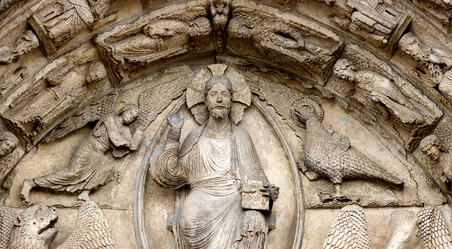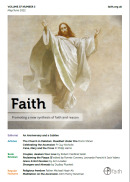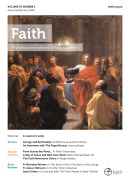Featured
Jesus Christ: Truly God
The exultation of Science is still evident in modern society and it has been fuelled by the condemnation of the validity of miracles and Christian teaching especially by philosophers such as David Hume, who argued: ‘No testimony is sufficient to establish a miracle…’, and Richard Dawkins, the atheist evolutionist who promulgates the belief that: ‘The true utility function of life, that which is being maximised in the natural world, is DNA survival.’ As a result of the loss of religious understanding, Christ is nowadays viewed by many as ‘simply a good person’ who helped the poor and the sick, just as Mother Teresa is remembered in popular culture as a nun who cared for exactly the same people in Calcutta, India, rather than a woman of intense piety who truly obeyed Jesus’ new commandment: ‘I give you a new commandment: “love one another;”’ I believe that the view that Christ was ‘simply a good person’ is wrong and that he was neither madman nor liar rather he truly was ‘The Word [that] became flesh and dwelt among us…’
Liturgy: Beauty and Renewal

The timeless Mass
Every Mass takes place across the boundaries of time. Every Mass is one with Christ's one sacrifice on Calvary, every Mass unites us with the saints in Heaven and hence with eternity. Every Mass is “the Mass of all ages”.
Of course, each Mass also has its fixture here in earth: 8, 9 and 11.15 am, on Sunday at St Awfully Ordinary, Parknshopcity, or whatever. The church may be a glory of 19th century gothic revival, or a fearsome 20th century blend of concrete and children's artwork, or perhaps an echoing ancient building in some part of Europe where the Faith was not lost in the religious trauma of the 16th century but now seems to be receding fast in the face of the secularism of the 21st. But the Mass, wherever it is, is always and everywhere the Mass of all time.
A Renewal of the Sacred

After the appalling atrocity in Paris, ordinary people, from all walks of life, appeared at impromptu rituals by the wayside. It was very moving to see them light candles and bring flowers to the scenes of the tragedy or to national monuments. At the same time, I could not help but notice the improvisation and the impoverishment of what they were doing. It was very much ‘pick’n’mix and’ make it up as you go along’.
Music and the Liturgy

In its essence music is an aural experience. All music shares common elements,dealing with sound: pitch (how high or low), dynamics (how loud or soft), rhythm (the combination of long and short sounds), tempo (how fast or slow) and timbre (the sound produced by combinations of different instruments). In the Western musical tradition these can all be written using a common method known as staff notation. But music has different uses and functions.
The Renewal of Christian Philosophy
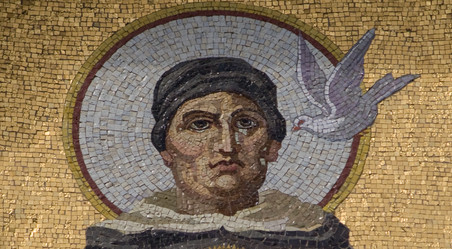
We must ask whether, in the early years of . . . [the 20th] century, there was any similar crisis of faith and intellect in the life of the non-Catholic Christian communities. We know very well there was. What was then called ‘Modernism’ in Catholic circles, divided and continues to divide those Churches in the very heart of their faith, witness and moral life. This self-division is the main reason for the loss of faith, practice and Christian in uence in the life of their peoples and nations. A Church without the literal Divinity of Christ is a Church without guiding authority over the life of man.
Interview with Peter Seewald
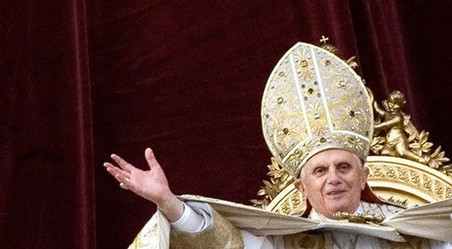
Without any doubt he is one of the most signi cant thinkers of the 20th century - and as a theologian the greatest pope of all times. As a thinker he intrigued and inspired the world with his timely re ections and diagnosis about the change of society. And he proved to be right - though unfortunately his words weren’t adequately heeded.
Pope Francis, the Catholic faith and the 'unity law'
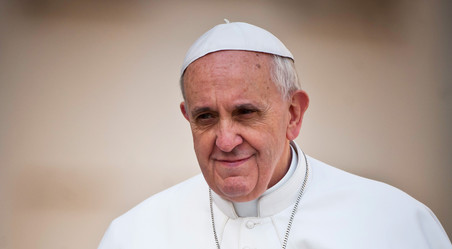
Pope Francis caused controversy with the publication of his encyclical Laudato Si´, (LS), concerned with humanity, climate change, social cohesion and spirituality. The fact that climate change is politically and, to a lesser extent, scientifically controversial means that this encyclical has been read by many scientists and non-Catholics. Indeed, Nature magazine stated:
“...the Pope’s recognition of human-induced global warming is an unflinching rebuke to climate-change doubters who might have hoped to find an ally in the Catholic Church.”
Book Reviews

At the outset the author lets us know that this book is a revised version of chapters that appeared in his earlier Ethos and the Oxford Movement published in 2007. This earlier version is still available on Kindle price £78, which is one reason why I am grateful that Pereiro has seen fit to produce a cheaper version. The other reason is that he has opened up an interesting perspective on the religious phenomenon which was the Oxford Movement. R. W. Church wrote the first broad account of that “short scene of religious earnestness and aspiration”. Since then there have been numerous individual treatments of the principal characters: Newman, Keble, Froude, Pusey, Williams, Marriott and Church. Each had their part to play – Newman, Keble and Froude in the central role.
-
Jesus Christ: Truly God
Joseph Ruane FAITH MAGAZINE January - February 2016
In the 2015 Catholic Young Writer Award, pupils at Catholic secondary schools across Britain were invited to discuss the claims of Jesus Christ. They were given the following passage from CS Lewis' Mere Christianity and asked to discuss the statement that he makes:
Joseph Ruane is a VI form pupil at Ampleforth College, and spent his early secondary education at the Cardinal Heenan High School, Leeds.
In the secularised world that we inhabit today, many people are too hasty to condemn Jesus Christ as ‘a liar’ and ‘a madman’. In the aftermath of the publication of Charles Darwin’s ‘Theory of Evolution’ in 1859, religious belief became lost to Victorian society and was gradually replaced with scientific principles which the author Joseph Conrad described in his 1907 novel ‘The Secret Agent’ as ‘the sacrosanct fetish of the day…’
Simply a 'good person'?
The exultation of Science is still evident in modern society and it has been fuelled by the condemnation of the validity of miracles and Christian teaching especially by philosophers such as David Hume, who argued: ‘No testimony is sufficient to establish a miracle…’, and Richard Dawkins, the atheist evolutionist who promulgates the belief that: ‘The true utility function of life, that which is being maximised in the natural world, is DNA survival.’ As a result of the loss of religious understanding, Christ is nowadays viewed by many as ‘simply a good person’ who helped the poor and the sick, just as Mother Teresa is remembered in popular culture as a nun who cared for exactly the same people in Calcutta, India, rather than a woman of intense piety who truly obeyed Jesus’ new commandment: ‘I give you a new commandment: “love one another;”’ I believe that the view that Christ was ‘simply a good person’ is wrong and that he was neither madman nor liar rather he truly was ‘The Word [that] became flesh and dwelt among us…’
CS Lewis
C.S. Lewis writes in ‘Mere Christianity’ that: ‘You must make your choice. Either this man was, and is, the Son of God, or else a madman or something worse. You can shut him up for fool, you can spit at him and kill him as a demon; or you can fall at his feet and call him Lord and God.’ During his own ministry and lifetime, as now, Christ was condemned by those who heard his message: “Many said: ‘He is possessed, he is raving; why do you listen to him?’” Throughout the Gospels it is easy to empathise with the Jewish men and women who heard and condemned Jesus, he certainly makes extremely bizarre statements which, if not understood in light of his life, would certainly result in his admission to a mental institution today.
The Eucharist
Such a statement can be seen in Matthew 26:26-28 (NJB) during the institution of the Eucharist: “Now as they were eating, Jesus took bread and when he had said the blessing he broke it and gave it to the disciples. ‘Take it and eat,’ he said, ‘this is my body.’ Then he took a cup, and when he had given thanks he handed it to them saying, ‘Drink from this all of you, for this is my blood, the blood of the covenant, poured out for many for the forgiveness of sins.’” Clearly, to a non-believer, this could be interpreted as cannibalism, yet in the light of Jesus’ ministry it is the beginning of a new relationship between God and his people. In the Book of Exodus 24, Moses seals the Covenant with the blood of bullocks which he put into basins and sprinkled on the altar. In the Gospel of Matthew, the blood of Jesus shed upon the cross seals the new covenant between God and humanity, shown here in the celebration of the first Eucharist. Some characteristic features of madness are inflexibility, irritability and a belief in what is irrational. The Jesus Christ that one encounters in the four Gospels does not present any of these characteristics. We are presented with a man who is deeply compassionate and understanding of the situations of the everyday people of Judea. Christ was not inflexible nor was he irritable, as is shown in the Gospel of Mark 2:13-17 (NJB) in which it is recorded that Jesus called Levi and ate with sinners saying to those who condemned him: ‘It is not the healthy who need the doctor, but the sick. I came to call not the upright, but sinners.’ Through the action of eating with sinners, Jesus broke every social and political convention of his society. John Dominic Crossan examined this commenting: “Jesus’ kingdom of nobodies and undesirables in the here and now of this world was surely a radically egalitarian one, and as such, it rendered sexual and social, political and religious distinctions completely irrelevant and anachronistic.’ These are not the actions of a ‘liar’ or a ‘madman’; these are the actions of a man who firmly believes in himself and his mission. The conviction that Jesus shows in the Gospel of Mark earned him many powerful enemies in the Pharisees. And although these authorities did try to ‘shut him up for fool’, ‘spit at him’ and ‘kill him as a demon’ they failed and the testament to that is 2000 years of ecclesiastical history which witnesses presently over 1.5 billion people falling at the feet of Jesus Christ and calling him ‘Lord and God.’ A madman who claimed to be divine would act in a megalomaniac fashion, exalting himself; Jesus humbles himself throughout his ministry. An example can be seen in Mark 7:24-30 (NJB) when Jesus heals the daughter of the Syro-Phoenician woman. Jesus humbles himself simply by conversing with this woman who was a Gentile; this fact meant that he should have ignored her. Christ did not ignore her; he listened to her troubles and healed her daughter of an unclean spirit, most definitely not an action of personal exaltation but the action of a Saviour.
The birth of Jesus Christ was the culmination of thousands of years of prophetic witness which can be observed clearly in the Old Testament. In his work ‘Born to be King: The Epic of the Incarnation’, Dom. Bernard Orchard OSB writes that the account of the birth of the God-Man in the Gospel of Matthew clearly states that Mary was a virgin when she conceived by the Holy Spirit and that this fulfilled the prophecy of Isaiah 7:14 in which it is stated that the Messiah would be born of a virgin. There are further prophecies in the Old Testament that also herald the coming of Jesus and which were fulfilled during the infant stages of Jesus’ life. For example, in Micah 5:2 (NJB) it is written: ‘But you (Bethlehem) Ephrathah, / the least of the clans of Judah, / from you will come for me / a future rule of Israel / whose origins go back to the distant past, / to the days of old.’ This was of course fulfilled when Caesar Augustus decreed that the census should be taken and Joseph took his pregnant wife Mary, to his hometown of Bethlehem, where she gave birth to a son. There are many more examples of prophecies such as this scattered throughout the Old Testament. In the New Testament too, prophecies were made regarding the greatness of the Christ. When Mary and Joseph took their infant son to be baptised in the temple, Simeon blessed Jesus by saying the ‘Nunc dimittis’: “Now, Master, you are letting your servant go in peace / as you promised; / for my eyes have seen the salvation / which you have made ready in the sight of the nations; / a light of revelation for the gentiles / and glory for your people Israel.” In the Temple, we witness Simeon prophesying the salvation that Jesus Christ will bring to all the nations as the Light of the World. The Catechism of the Catholic Church identifies that in Hebrew, the name Jesus means: ‘God saves’. The Church also tells us that: ‘In Jesus, God recapitulates all of his history of salvation on behalf of men.’ This encapsulates the prophecies of both the Old Testament and the New. The prophecies of Isaiah, Micah and Simeon all predict a Messiah who will bring salvation to all. The very fact that the name of this Messiah means ‘God saves’ shows that no matter what Jesus was like as a person, the correlation of these texts and language, written at different times and in different places all communicate the same message: Jesus was the Son of God, the Word made flesh and thus, one cannot deny it, he had to be telling the truth.
The sincerity that was demonstrated by Christ during his ministry is a character trait that shows that truthfulness lay behind his public life. If Christ was merely a liar then his sincerity would not have prevailed at the Garden of Gethsemane and he would have denied his claims to be ‘King of the Jews’, in order to save his life. Similarly, if he was ‘a madman’ those who saw the miraculous events of Jesus would have dismissed him. Throughout the Gospels, we see that those whom Judean society dislikes become pariahs. For example, the lepers were forced to live separated from the community and humiliatingly forced to warn others of their uncleanliness when they were in public places. If Christ was thought to be mad by his contemporaries for the claims he made then he would have found himself in a similar situation; that is not the case. In Mark 10: 46-52 (NJB), Christ heals Bartimaeus at Jericho. This social outcast cried out to Jesus: ‘Son of David, Jesus, have pity on me.’ Befitting of his status Bartimaeus was promptly hushed by those who were following Jesus yet he persisted and the Lord had pity on him: “Go; your faith has saved you.’ And at once his sight returned and he followed him along the road.” Christ was, as when he ate with the sinners, placing himself in social jeopardy. This determination and sincerity are proof that Jesus was God. Furthermore, only a divine being had the power to forgive the sins of Bartimaeus. Jesus had previously demonstrated this divine power when he healed the paralytic which is recorded in Mark 2:1-12 (NJB) in which Jesus says: “But to prove to you that the Son of man has authority to forgive sins on earth’ – he said to the paralytic – ‘I order you: get up, pick up your stretcher, and go off home.” Another claim that only a divine being could make is to have power over nature. This is what separates Jesus from both ‘madmen’ and ‘liars’; his control of the elements. This can be observed in Mark 4:35-41 (NJB) in which Jesus calms the storm that threatened to sink the disciple’s boat: “And he woke up and rebuked the wind and said to the sea, ‘Quiet now! Be calm!’ And the wind dropped and there followed a great calm.” From the beginning of creation, God has always been love and through Jesus’ ability to forgive sins and his power over nature, God’s love is revealed to the world, what has always been is now radiated by a seemingly insignificant carpenter from Nazareth. Even those who were foreign and not even from Judaea recognised the outpouring of divine love emanating from the person of Jesus as Bartimaeus did. The Gospel of Matthew records the visit of the Magi from the East. These men are traditionally recognised as Persians who would have followed the Zoroastrian religion. Many scholars question the historical nature of the visit of the Magi; however regardless of their existence the event has symbolic value in that it shows Matthew the Evangelist’s estimations of the child Jesus as Son of the Most High. The Magi would have had little or no knowledge of the Hebrew Scriptures yet their visit fulfils Isaiah’s prophecy that all nations shall worship the Lord. The Magi and Bartimaeus show that those on the fringes of Jesus’ culture recognised him as divine even if those who were administering the Jewish religion were blind to this. The sincerity with which Christ received those who came to him again adds weight to the view that Jesus Christ was truthful in his preaching and teachings.
If Jesus Christ was both ‘a liar’ and ‘a madman’ then his teachings would have been dismissed by all as he breathed his last on Calvary. However, this is not so and a clear example of this can be clearly seen in the figure of St Paul. Paul the Apostle was, prior to his blinding on the Road to Damascus, known as Saul of Tarsus, a man who persecuted the early disciples of Jesus around Jerusalem with enthusiasm. However, Paul’s experience on the road changed him dramatically and as a consequence of this experience Paul, too, came to believe in the picture of Jesus offered by the community of the disciples. Through the disciples we receive evidence that Jesus was a man, a historical figure, their writings are in some sense historical records and as Christians we must accept the word of these writings in order to believe in the divinity of Jesus. This is emphatically shown in the Letters to the Corinthians which profoundly show that Paul had a deep understanding of Christ’s divinity and believed him to be transparent. In the First Letter to the Corinthians, Paul takes the Credo of Judaism and adapts it to encompass Christ: ‘For us there is one, only God, the Father, from whom all things come and for whom we exist and one Lord Jesus Christ, through whom all things come and through whom we exist.’ In this bold statement to the Church in Corinth, Paul demonstrates that now the one God and Lord has become the one God the Father and the one Lord Jesus Christ. Paul doesn’t create two gods; he shows that ‘there are now two persons confessed in this central statement of monotheism.’ He expands on this in the Second Letter to the Corinthians, specifically 2 Corinthians 6:2 (NJB) in which Paul writes: “As he said, ‘At the time of my favour I have answered you; on the day of salvation I have helped you;’ well now is the real time of favour, now the day of salvation is here.” In this passage there is emphasis is placed, by Paul, upon the salvation that Christ brings to humanity. As Simeon recognised the saving nature of Christ at his birth, so too does Paul at his rebirth. St Paul can see that God has, through Christ, completed his covenant with Israel; to provide them with salvation. Thus Christ had to be telling the truth. For a man so intent on destroying Christianity to rescind his beliefs and assume the mantle of an apostle shows that Christ was the son of God. As I stated earlier, if Christ was simply ‘a madman’ and ‘a liar’ then his teachings wouldn’t have endured even amongst those who believed in him during his lifetime. The fact that his teachings had the power to convert those who did not believe after he was dead and resurrected shows that they were truthful. Saul, the unbeliever became Paul, the believer who through his manipulation of the Credo of Judaism undoubtedly shows that he understood Jesus Christ to be truthful in proclaiming himself to be the Son of God.
Ultimately, I believe that Jesus Christ was the Son of God. Although many people have and will continue to accuse Christ of being ‘a liar’ and ‘a madman’, the evidence of prophecies, Christ’s personality and the effects of his ministry show that these convictions are misplaced. One must concede however that the fulfilment of prophecy only has weight for those who regard the Bible as the Word of God such as Matthew, Paul and the worldwide Christian population. Regardless of this fact, modern thought has made us blind to the nature of prophets. We believe now that our only knowledge lies in science and that one day, science will provide an answer for all things, even God. Long before the time of Jesus, many were conscious of prophecy. There was a spirituality that all men and women possessed and recognised that has since been lost with the advent of modern technology. The Ancients for example had the Sibylline oracles whom they believed to be interpreters of divine will. This belief endured amongst the early Christian communities until it was eventually quashed by the Church. The spiritual openness of those people 2000 years ago meant that, as in the Parable of the Sower, the message was heard and it grew tall and strong in the hearts of those who heard it, yielding a good crop. In modern times, the message has fallen upon the edge of the path, on the rocky ground, amongst the thorns and it is being destroyed. It is leading people to disregard Christ and restrict the magnitude of his divine being to the label of ‘simply a good person’. Those that do not allow the seed to fall upon the fertile soil of their souls are eager to accuse him of being ‘a liar’ and ‘a madman’ as they would rather lead a purely utilitarian life rather than experience the grace and love that He willingly offers.


